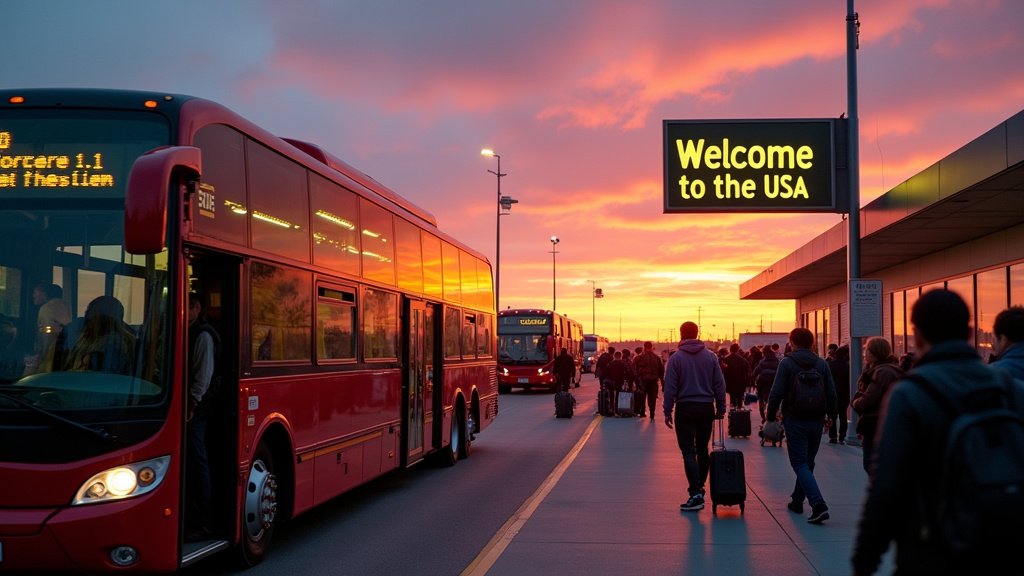Border Crossing Trends: Bus Passenger Data Reveals Shifting Patterns from 2019 to 2025
Washington, D.C. – A new report released on July 22, 2025, by the Bureau of Transportation Statistics (BTS) offers a detailed examination of the trends in bus and bus passenger border crossings between 2019 and 2025. The data paints a picture of fluctuating passenger numbers, impacted by events like the COVID-19 pandemic and broader economic and social shifts. The report provides valuable insights into cross-border travel patterns, highlighting key changes in both passenger volume and the ports of entry experiencing the most significant shifts.
Northern Border Dynamics: Blaine Stands Out
Analyzing the initial data from January to April 2025, the report reveals a notable trend along the northern border. Passenger numbers experienced an overall decline across the top 5 northern border crossing ports of entry. However, one port stands out against this trend. Blaine, Washington, showed a remarkable increase in bus passenger traffic during the same period. Specifically, Blaine witnessed a substantial 35.9% increase in bus passenger numbers, indicating a significant shift in travel patterns at this particular port. This contrast with the general decline underlines the localized dynamics influencing border crossings.
Southern Border: Growth in Eagle Pass
In contrast to the trends observed on the northern border, bus passenger numbers along the southern border present a more evenly distributed picture. While no single port dominated the narrative as dramatically as Blaine, Texas, a port of entry, Eagle Pass, experienced a significant surge in bus passenger volume. In April 2025, Eagle Pass reported a substantial 38% increase in bus passengers compared to the figures from April 2024. This growth suggests a potentially changing dynamic in border crossings, with increased activity in specific locations along the southern border.
Overall Decline in Crossings from 2019 to 2024
Looking at the broader picture from 2019 to 2024, the report illustrates a general reduction in overall cross-border travel by all modes of transportation. During this period, the total number of incoming persons crossing the border decreased. Specifically, a 13.5% decrease was observed from Canada, highlighting the impact of various factors on travel between the two countries. The report also noted a smaller decrease from Mexico, at 0.7% over the same five years, demonstrating how trends vary in the two regions.
Impact on Bus Crossings: Divergent Trends
The report then dives into the specifics of bus traffic. From 2019 to 2024, bus crossings from both Canada and Mexico experienced a decline. The report shows that bus crossings from Canada decreased by 34.5%, highlighting a significant reduction in the number of buses crossing the border. Similarly, bus crossings from Mexico saw a 12.4% decline. However, passenger trends within these figures present an interesting dichotomy. While the number of buses decreased, the passenger numbers did not move the same direction. The number of bus passengers from Canada decreased by 37.0%, which is proportionally similar to the drop in buses. Meanwhile, the number of bus passengers from Mexico increased by 2.6%. This contrasting trend suggests that changes in bus capacity, utilization, or passenger demographics may have influenced the figures.
The Pandemic’s Impact: U.S.-Canada Border Closure
One of the most significant factors influencing these trends was the COVID-19 pandemic and its associated border restrictions. The report specifically highlights the impact of the U.S.-Canada border closure. The border was closed to non-essential travel in 2020 and remained closed for 19 months, severely impacting cross-border movement. Following the reopening of the border, the number of bus passengers per bus dramatically surged. This surge indicated a pent-up demand for travel and the reopening led to an increase of 145.3% in bus passengers per bus from Canada. From Mexico, the reopening resulted in a rise of 17.9%, demonstrating the lasting consequences of the pandemic and the subsequent recovery in travel demand.
Conclusion
The BTS report provides a comprehensive look at the changing landscape of bus and bus passenger border crossings between 2019 and 2025. The data reveals the influence of various factors, including the pandemic, shifts in port activity, and changing passenger demographics. The trends observed along both the northern and southern borders indicate the need for ongoing monitoring and analysis to understand the evolving dynamics of cross-border travel and its impact on transportation infrastructure and border security.






